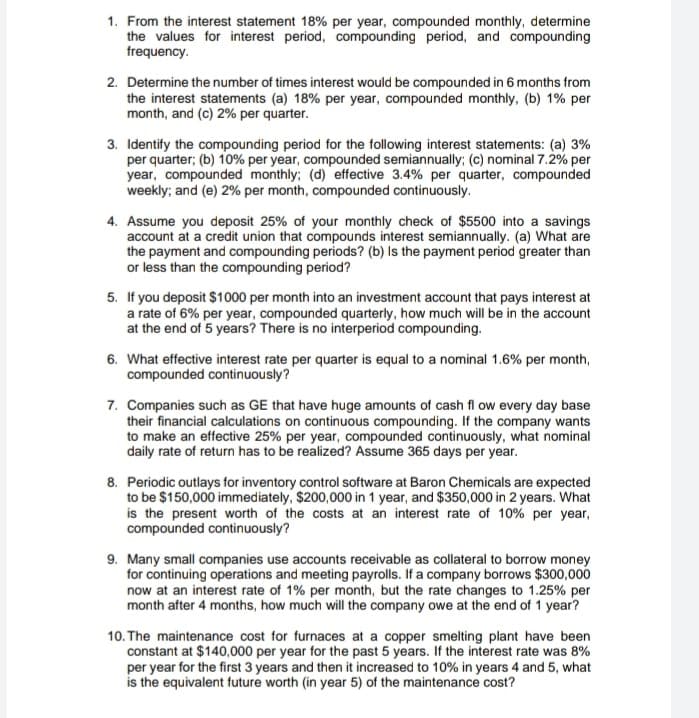From the interest statement 18% per year, compounded monthly, determine the values for interest period, compounding period, and compounding frequency.
From the interest statement 18% per year, compounded monthly, determine the values for interest period, compounding period, and compounding frequency.
Financial Accounting: The Impact on Decision Makers
10th Edition
ISBN:9781305654174
Author:Gary A. Porter, Curtis L. Norton
Publisher:Gary A. Porter, Curtis L. Norton
Chapter9: Current Liabilities, Contingencies, And The Time Value Of Money
Section: Chapter Questions
Problem 9.12E
Related questions
Question
Answer each problem and show the solution.

Transcribed Image Text:1. From the interest statement 18% per year, compounded monthly, determine
the values for interest period, compounding period, and compounding
frequency.
2. Determine the number of times interest would be compounded in 6 months from
the interest statements (a) 18% per year, compounded monthly, (b) 1% per
month, and (c) 2% per quarter.
3. Identify the compounding period for the following interest statements: (a) 3%
per quarter; (b) 10% per year, compounded semiannually; (c) nominal 7.2% per
year, compounded monthly; (d) effective 3.4% per quarter, compounded
weekly; and (e) 2% per month, compounded continuously.
4. Assume you deposit 25% of your monthly check of $5500 into a savings
account at a credit union that compounds interest semiannually. (a) What are
the payment and compounding periods? (b) Is the payment period greater than
or less than the compounding period?
5. If you deposit $1000 per month into an investment account that pays interest at
a rate of 6% per year, compounded quarterly, how much will be in the account
at the end of 5 years? There is no interperiod compounding.
6. What effective interest rate per quarter is equal to a nominal 1.6% per month,
compounded continuously?
7. Companies such as GE that have huge amounts of cash fl ow every day base
their financial calculations on continuous compounding. If the company wants
to make an effective 25% per year, compounded continuously, what nominal
daily rate of return has to be realized? Assume 365 days per year.
8. Periodic outlays for inventory control software at Baron Chemicals are expected
to be $150,000 immediately, $200,000 in 1 year, and $350,000 in 2 years. What
is the present worth of the costs at an interest rate of 10% per year,
compounded continuously?
9. Many small companies use accounts receivable as collateral to borrow money
for continuing operations and meeting payrolls. If a company borrows $300,000
now at an interest rate of 1% per month, but the rate changes to 1.25% per
month after 4 months, how much will the company owe at the end of 1 year?
10. The maintenance cost for furnaces at a copper smelting plant have been
constant at $140,000 per year for the past 5 years. If the interest rate was 8%
per year for the first 3 years and then it increased to 10% in years 4 and 5, what
is the equivalent future worth (in year 5) of the maintenance cost?
Expert Solution
This question has been solved!
Explore an expertly crafted, step-by-step solution for a thorough understanding of key concepts.
Step by step
Solved in 3 steps

Knowledge Booster
Learn more about
Need a deep-dive on the concept behind this application? Look no further. Learn more about this topic, finance and related others by exploring similar questions and additional content below.Recommended textbooks for you

Financial Accounting: The Impact on Decision Make…
Accounting
ISBN:
9781305654174
Author:
Gary A. Porter, Curtis L. Norton
Publisher:
Cengage Learning

Excel Applications for Accounting Principles
Accounting
ISBN:
9781111581565
Author:
Gaylord N. Smith
Publisher:
Cengage Learning

EBK CONTEMPORARY FINANCIAL MANAGEMENT
Finance
ISBN:
9781337514835
Author:
MOYER
Publisher:
CENGAGE LEARNING - CONSIGNMENT

Financial Accounting: The Impact on Decision Make…
Accounting
ISBN:
9781305654174
Author:
Gary A. Porter, Curtis L. Norton
Publisher:
Cengage Learning

Excel Applications for Accounting Principles
Accounting
ISBN:
9781111581565
Author:
Gaylord N. Smith
Publisher:
Cengage Learning

EBK CONTEMPORARY FINANCIAL MANAGEMENT
Finance
ISBN:
9781337514835
Author:
MOYER
Publisher:
CENGAGE LEARNING - CONSIGNMENT


Cornerstones of Financial Accounting
Accounting
ISBN:
9781337690881
Author:
Jay Rich, Jeff Jones
Publisher:
Cengage Learning
